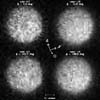| . |  |
. |
Dawn Principal Investigator: UCLA Pasadena - Mar 19, 2003 The solar system contains a spectrum of magnetic dynamos in large bodies like the Sun and Jupiter, in more modest-sized bodies like the Earth and in smaller bodies like Mercury and Ganymede. In ancient times even more solar system objects had operating magnetic dynamos. There have been so many dynamos that comparative planetology in this area shows much promise of providing insight both into the dynamo mechanism and the properties of the dynamo regions. In fact geochemical and paleomagnetic evidence from the HED meteorites suggests that Vesta formed an iron core and once had an internally generated magnetic field. This if confirmed would put Vesta as the smallest body on a sequence with the Moon, Mercury, Mars and the Earth as rocky planets at least once having a magnetic dynamo. Dawn allows us to survey Vesta and Ceres at orbital altitudes well below one body radius, and determine if they possess natural remanent magnetization and, through geologic correlations, when it was produced. The same instrument measures the transient response of Vesta and Ceres as discontinuous changes in the external magnetic field occur, placing constraints on the electrical conductivity of the interior.
The ranges and sensitivity of the magnetometer are tailored to the expected environments to be found at Vesta and Ceres as well as the magnetic environment of the spacecraft. We have conservatively chosen a � 1000 nT range for the magnetometer, sampled at 20 Hz. The data are digitized to 16 bits providing � 0.015 nT digitization. The UCLA magnetometer derives from a long line of missions including OGO5 (1968); ISEE 1 and 2 (1977), Pioneer Venus (1978); Galileo (1989); Polar (1996) and ST5 (in fabrication). The main electronics unit, a sensor triad, and a block diagram are shown in Figure 1. The main electronics and the sensors are completely redundant, use a single range and data rate and operate continuously. A third new technology magnetometer, with a design based on the sigma delta modulator, adds further redundancy. This overall instrument design was chosen because of its low-noise level, simplicity, low cost and its high inheritance from recent missions. The Dawn mission has been selected as NASA's ninth Discovery mission to be launched in May 2006 to orbit both Vesta and Ceres. Related Links Dawn Presentation: Asteroids, Comets and Meteors 2002 - PDF File Dawn at UCLA An Overview of Dawn SpaceDaily Search SpaceDaily Subscribe To SpaceDaily Express  Dulles - Jan 3, 2002
Dulles - Jan 3, 2002Orbital Sciences Corp has been selected to develop and build the first spacecraft designed to orbit main-belt asteroids for a total cost of $80 million excluding launch vehicle costs.
|
| ||||||||||
| The content herein, unless otherwise known to be public domain, are Copyright 1995-2016 - Space Media Network. All websites are published in Australia and are solely subject to Australian law and governed by Fair Use principals for news reporting and research purposes. AFP, UPI and IANS news wire stories are copyright Agence France-Presse, United Press International and Indo-Asia News Service. ESA news reports are copyright European Space Agency. All NASA sourced material is public domain. Additional copyrights may apply in whole or part to other bona fide parties. Advertising does not imply endorsement, agreement or approval of any opinions, statements or information provided by Space Media Network on any Web page published or hosted by Space Media Network. Privacy Statement All images and articles appearing on Space Media Network have been edited or digitally altered in some way. Any requests to remove copyright material will be acted upon in a timely and appropriate manner. Any attempt to extort money from Space Media Network will be ignored and reported to Australian Law Enforcement Agencies as a potential case of financial fraud involving the use of a telephonic carriage device or postal service. |